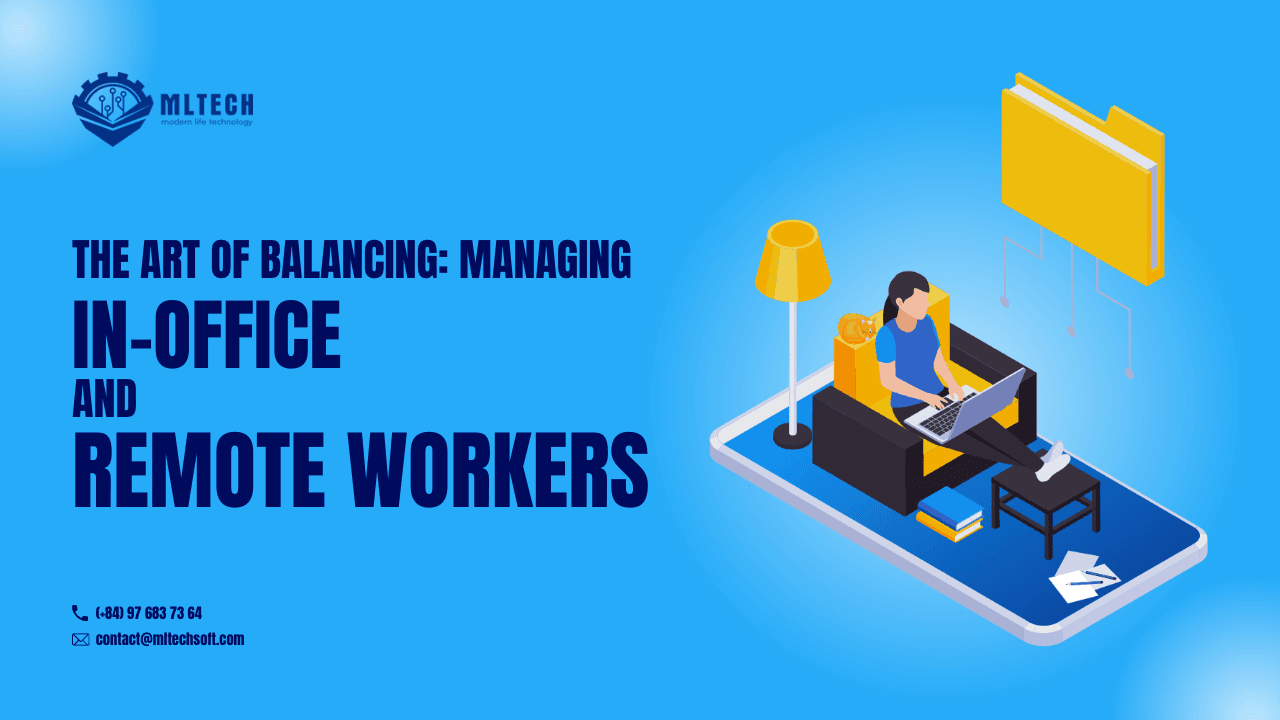Scroll down for more
The Art of Balancing: Managing In-Office and Remote Workers

Over the past three years, we have witnessed a pandemic named COVID-19 happening globally, which directly impacts the economy and human resources of all companies in most industries. When the epidemic became severe, all businesses changed how employees worked. In other words, the COVID-19 pandemic has transformed the way people work.
Most of us had to work from home during the pandemic and will hopefully work onsite when the pandemic goes away. Since the changes, we've had to adapt to a new work model called "hybrid working."
In this article, we will discuss the cons and pros of this model and the best way to balance onsite and remote workers in companies. This aims for employers to understand deeply about this model and apply it effectively in their businesses as needed.
Hybrid Work and the Challenges of Managing Hybrid Employees
The question is what "hybrid work" is. Many studies show that it is a model that allows employees to flexibly combine working at the office on certain days of the week with working from home. This model helps employees be flexible in their working space and working time to optimize the productivity of their companies.
Some enterprises, such as Google, Microsoft, and Facebook, applied this model because they saw more exceptional advantages than they thought.
If businesses apply this model successfully, it will have a lot of benefits for both them and their workers, such as reducing the risk of disease exposure, particularly during epidemic periods, which is still a hot issue that directly impacts human health and safety.
This model also has some constraints when managing employees. Employers should pay more attention to improving and applying them suitably.
It hasn’t yet been popular or applied effectively in most organizations. This model was employed solely during the COVID-19 pandemic; once the epidemic is controlled and the number of cases is reduced, the standard model still accounts for almost all businesses.
Remote management capacity is a problem. Reports and online meetings that do not assess the level of productivity of workers who work from home are its limitations. Furthermore, if they are not under someone's control, they will become distracted by various things nearby, affecting their performance.
Not suitable for all industries: Jobs related to sales, marketing, and technology will be proper because they will focus on the given task lists based on the percentage of work done. However, it does not match the banking and financial industries because it requires strict compliance with the process and high security.
Harder to collaborate with remote employees: Because each person has a different working time frame based on workload and concentrated working hours, it will inadvertently create a gap where employees will find it hard to communicate, particularly when discussing vital concerns in a short time.
Employee burnout is especially true for those working in the software business. When their most focused period is late at night, they will do it when other people are sleeping to boost attention, work efficiency, and sleep during the day.
However, the presence of other people in their homes during the day creates noise that interferes with their sleep. Then they'll have sleeplessness, and their work will pile up, forcing them to concentrate for long periods to solve and do tasks and exhausting them.
Employee isolation: This is one of the most common complaints in the workplace. If they work onsite, they can interact with colleagues face-to-face and get to know new faces in the company. However, by working via a laptop screen and the internet, they would not get the company's circumstances, feeling lonely and disconnected from everyone.
Above are some drawbacks of the hybrid working model that all employers must acquire to compare the company model and offer the best strategies, if applicable.

Set clear expectations.
According to the definition of "remote working”, this model focuses on the time between working from home and working from the office for employees, so employers must set clear expectations for them. The expectations are their work schedule, communication, productivity, and deliverables.
Setting clear expectations is very important for hybrid employees because it motivates them to work and be under control.
Help workers understand what's expected. As they know their work's expectations, they can focus more on completing those goals. Increased responsibility: With defined expectations, they are more likely to take accountability for their work and meet their commitments.
Improves communication: With clear expectations, employees and stakeholders can communicate more effectively. They will know to seek guidance or answers from others for all inquiries, and supervisors can provide support promptly to guarantee employees meet the goals.
Increases productivity: With obvious expectations, they can prioritize their work based on the most crucial level and focus more on the highest, which results in increased productivity and efficiency, as well as better time management.

Strategies for communicating expectations
Communicating expectations is vital for setting explicit guidelines, as it helps employees acquire what they expect from them. To deliver on their expectations effectively, employers should highlight some points:
Be clear and specific. Use easy words and concrete examples to clarify what you want, and avoid using vague language to create confusion or assume that the other person knows what you mean.
Be active in listening. Effective communication is two-way. Listen actively to the other person's concerns, give feedback, and adjust your expectations.
Follow up. Follow up and monitor the expectations regularly to ensure they are met. Businesses can check log time, performance evaluations, and daily meetings.
Applying these strategies, employers can effectively communicate their expectations and ensure those involved are on the same page.
Foster Communication
The role of communication in managing hybrid employees
Communication helps employees manage not only onsite but also remote work.
Communication is the sole channel for employers to get insight from their workers and deliver on their expectations.
Communication helps employees understand their work deeply. Employees value open communication in the workplace because it makes them feel at ease to express their thoughts, worries, and discussions and receive feedback quickly.
Use of technology to keep remote employees connected and engaged
Because the hybrid model relies heavily on the Internet and personal laptops, employees will go to the company less frequently. As a result, using technology for remote work is a dispensable part of seamless operations.
The use of technology at work makes it easy for everyone to communicate and exchange information, and managers can track employee duties to guarantee that the stated goals are completed as intended.
Companies can utilize numerous technologies, including internal communication applications such as Telegram, WhatsApp, and Skype; information-sharing channels like Microsoft Teams; conferences via Google Meet and Zoom; and ask-tracking software such as Jira and Trello.
By leveraging technology to work creatively, organizations can keep remote employees connected, engaged, and productive while promoting a positive and inclusive work culture.

Encouraging in-office employees to communicate with remote counterparts
Once in-office and remote employees are encouraged to communicate actively, the invisible communication gap will be reduced. Employee communication is critical to emphasizing the value of collaboration and teamwork and guaranteeing that people are on the same page and do not feel separated.
They are always connected and engaged if they use collaborative tools such as conferences, internal communication channels, and project management software. To help remote workers have more connections to the team, businesses should invite them to team meetings and social events.
Another way for employees to be open-minded and empathic toward their remote peers is to recognize and applaud successful teamwork to finish tasks well, regardless of geographic boundaries. This might promote team spirit and strengthen their bond.
Provide the right tools
The importance of providing the right tools and technology for hybrid employees
Technology has contributed to tightening the relationships between colleagues, helping them catch the newest information, and enhancing productivity. Therefore, choosing the proper tools and technology is very important. More specifically:
Develop productivity: Hybrid employees can work efficiently and effectively via the appropriate tools and technology to meet their goals and deadlines.
Collaboration: By providing the right tools, such as video conferencing software, instant messaging platforms, and project management software, they can keep up with and collaborate effectively with their colleagues, regardless of their location.
Work-life balance: By providing the right tools and technology, such as mobile devices and cloud-based software, they can work whenever and wherever they want, which can help improve their work-life balance.
In conclusion, providing the right tools and technology is critical for the success of hybrid employees. It helps boost productivity and foster collaboration and work-life balance, which can generate value for the organization.
Discussion of necessary tools and hardware
The equipment and hardware can vary substantially depending on the available work or project. However, there are a few indispensable pieces of equipment and gear that are widely utilized in a variety of areas and businesses. For example:
Computer: It is a necessary tool for the majority of modern-day work. Computers or laptops are a significant part of hybrid working since they allow us to process jobs ranging from basic to advanced.
Internet Connection: Accessing online resources, talking with people, and exchanging information all require an Internet connection. It enables us to complete our tasks without interruption.
Mobile devices, such as smartphones and tablets, can help keep you up to date while on the go, accessing data, and accomplishing activities remotely. These are packageable things that may be taken anywhere as long as they are linked to the internet.
Earphones: These varied earphones help employees focus on their work, properly hear the substance of meetings, and avoid irritating those around them.
Create a hybrid work culture.
The importance of inclusiveness and collaboration in a hybrid work environment
In a hybrid workplace, inclusivity and collaboration are more crucial than ever for various reasons.
First and foremost, it promotes equal possibilities for everybody when they can contribute to and share in the team's success. They are all on the same page with mutual collaboration, regardless of location or working hours.
Increasing team cohesion: Collaboration is essential for forming a seamless team to work effectively and productively. Instead of feeling separated or isolated from their colleagues, employees actively share their ideas and knowledge with the group to advance all peers.
Creating an inclusive workplace and good team cohesion will foster creativity, which will be the team's next step. The more creative ideas there are, the more innovations there are to improve the working process, among other things.
Inclusivity and collaboration are critical for establishing a successful and productive hybrid work environment. Companies may foster a culture where all team members feel appreciated, connected, and empowered to contribute to the group’s success.
Strategies for creating a hybrid work culture
In hybrid working, it is important to pay greater attention to culture to ensure that people are engaged and connected rather than isolated or disconnected.
Companies can concentrate on the most basic methods of gathering all employees in frequent meetings to debate, release new information or regulations, or even congratulate the outstanding individual or team of the quarter or year. This way, it not only brings employees together but also pushes them to work hard.
Another option is to organize internal events around holidays. This will be an excellent opportunity for both in-office and remote staff to meet and communicate in person. Nothing beats meeting in person; employees might develop new acquaintances in the firm who do not work directly with them.
Offer Flexibility
The benefits of offering flexibility in a hybrid work environment
The nature of a hybrid work environment is flexibility between remote and onsite working models. Flexibility in this working model is considered the primary factor because of:
Improved work-life balance: Employees can adjust their work schedule to accommodate personal obligations while still meeting their work responsibilities.
Boost productivity: Thanks to work-life balance, employees can separate two fields in life. They will focus on their work as other things are done; consequently, they won't be bothered by others, leading to higher levels of concentration and generating productivity.
At the same time, firms can hire people with high professional qualifications and skills without regard to geography, which will provide the company with a competitive advantage when entering new markets as well as enhance the company's brand.

Discussion of strategies for offering flexibility
Recognizing the necessity of flexibility in a hybrid working model, businesses must consider appropriate tactics for the overall business scenario.
Remote schedule: Businesses can set up a link so employees can register and managers can manage and monitor the details. Businesses can be flexible enough for anyone who worked late last night to miss the daily meeting the next day, ensuring their health.
Employees can report the work process by email, meeting, or instant chat rather than in person if the company is flexible in the work process, which motivates people to work harder to produce good results to report.
Conclusion
The hybrid working model has rapidly gained favor in corporations and businesses due to the benefits that exceed expectations; yet, this model still has some limits that need improvement.
Businesses can fully capitalize on the benefits by balancing and applying people and technology strategies harmoniously and reasonably.
Get our blog
Want the latest and greatest from our blog straight to your inbox? Chunk us your details and get a sweet weekly email.
Read more in our blog

Project Management
The Impact of Dynamic Pricing on Customer BehaviorExplore the impact of dynamic pricing on customer behavior and learn how to implement effective pricing strategies.

Project Management
Focus in Scrum: Keeping Your Team on TrackDiscover effective strategies to maintain focus within your Scrum team, overcome common challenges, and boost productivity.

Project Management
Key Metrics for Mobile App SuccessDiscover the essential metrics for mobile app success, from user acquisition and engagement to monetization and performance.
MLTECH SOFT